人教版(2019)必修 第二册Unit 1 Cultural Heritage Assessing Your Progress & Video Time课件(共41张PPT)
文档属性
| 名称 | 人教版(2019)必修 第二册Unit 1 Cultural Heritage Assessing Your Progress & Video Time课件(共41张PPT) | 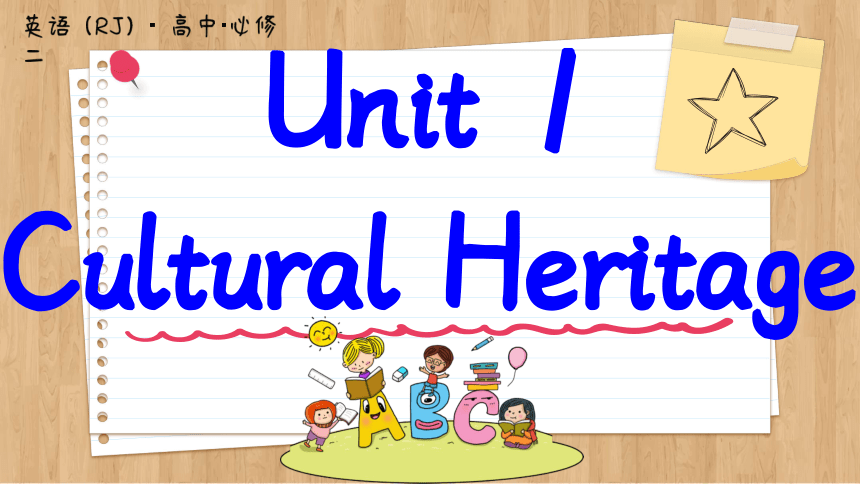 | |
| 格式 | pptx | ||
| 文件大小 | 132.5MB | ||
| 资源类型 | 教案 | ||
| 版本资源 | 人教版(2019) | ||
| 科目 | 英语 | ||
| 更新时间 | 2024-04-17 23:10:05 | ||
图片预览



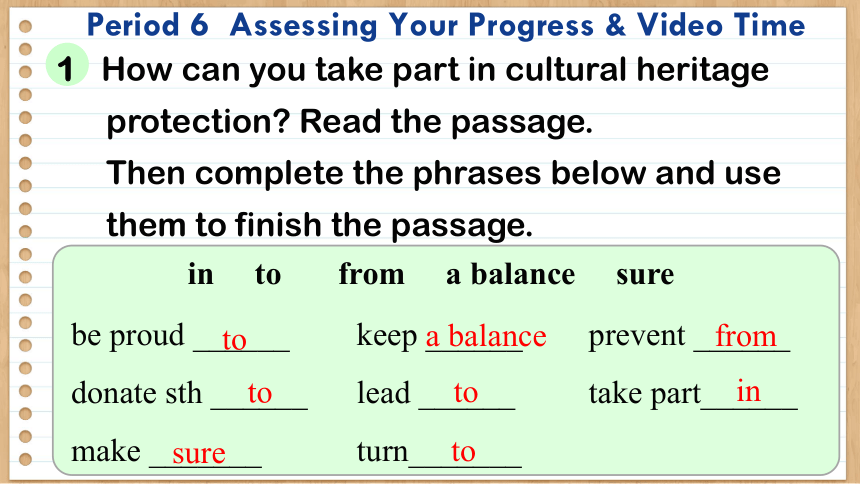


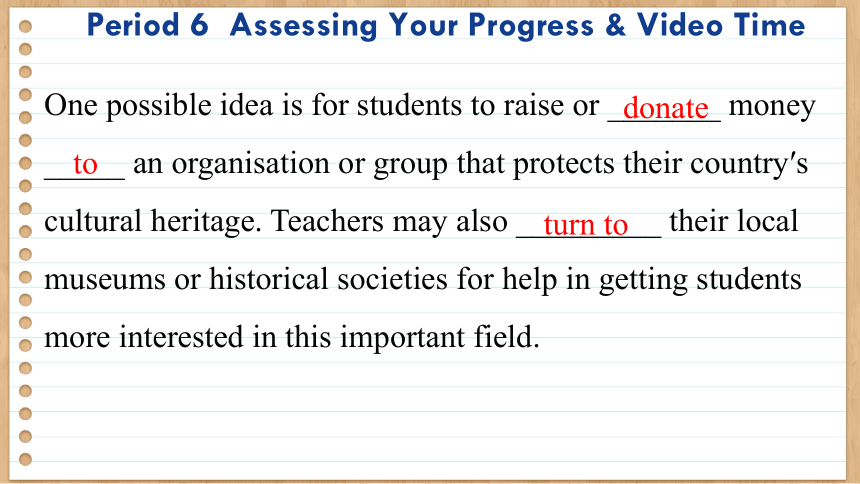
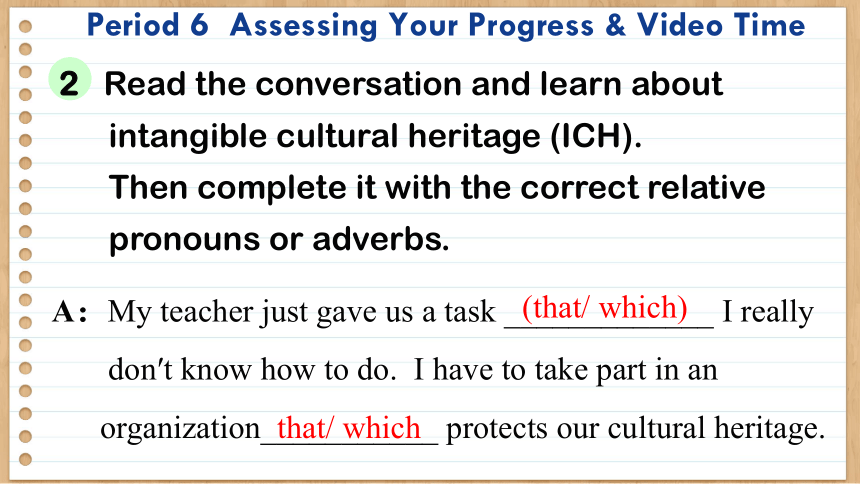
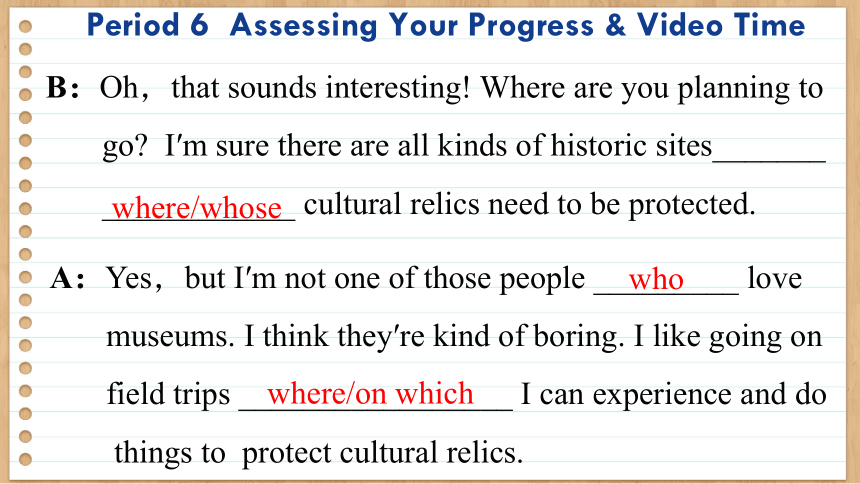
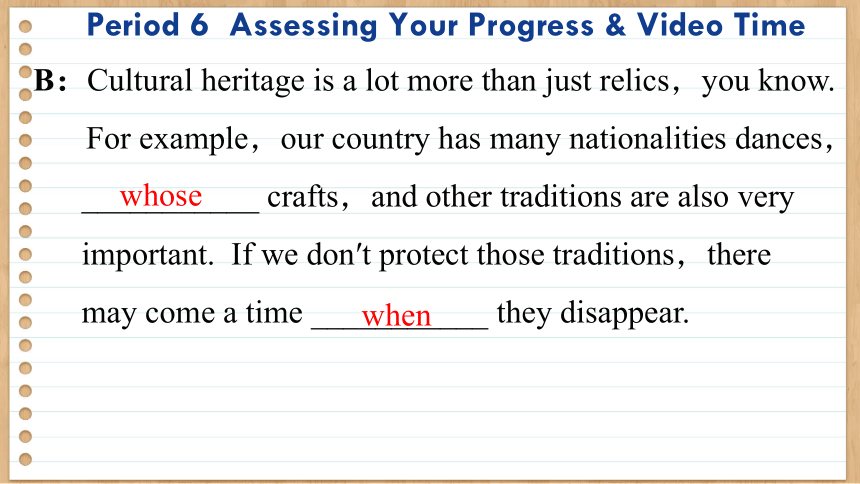
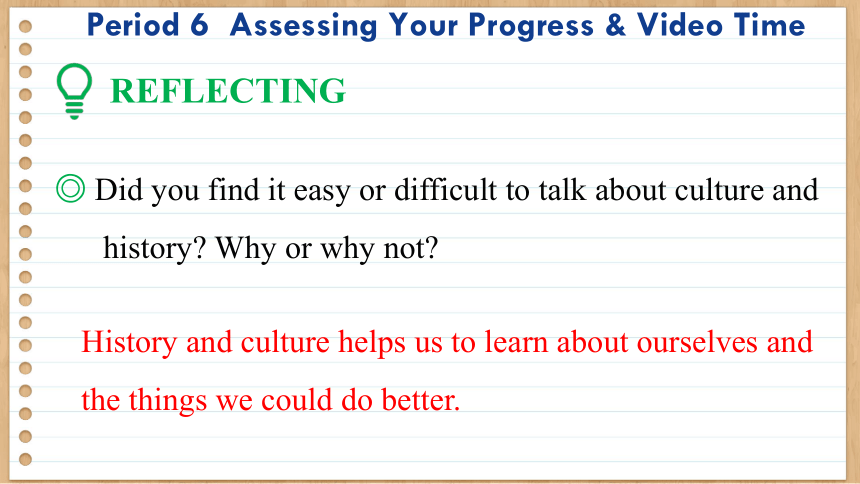
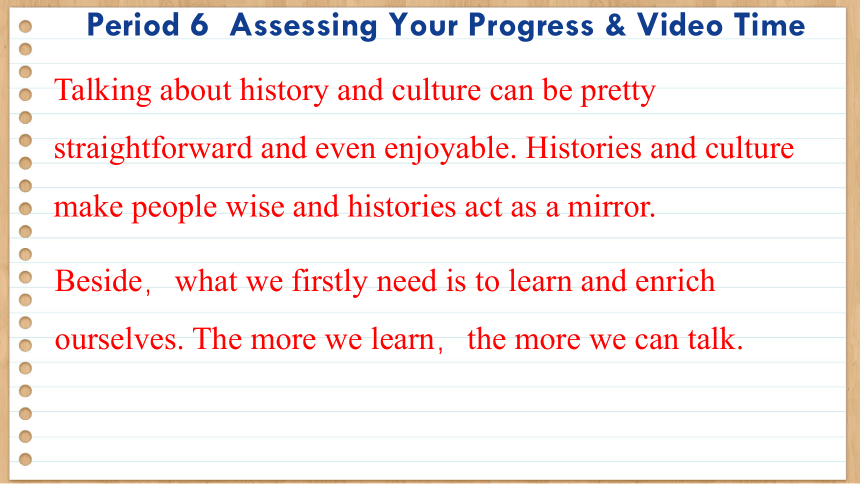
文档简介
(共41张PPT)
Unit 1
Cultural Heritage
Period 6
Assessing Your Progress & Video Time
Assessing Your Progress
1 How can you take part in cultural heritage
protection Read the passage.
Then complete the phrases below and use
them to finish the passage.
in to from a balance sure
be proud ______
donate sth ______
make _______
keep ______
lead ______
turn_______
prevent ______
take part______
to
a balance
from
to
to
in
to
sure
Getting young people to ____________ activities to protect their national heritage is a good way to introduce them to their country′s history. As they learn more about where they come from,they will hopefully ___________ tell others about their country and culture. Of course,teachers must
______________ between teaching the good and bad parts of a country′s history. Learning only the good parts can __________ narrow thinking.
take part in
be proud to
keep a balance
lead to
Learning the bad parts may help __________ those kinds of things ___________ happening again. Students who know their history and culture are more likely to _____________ that their cultural heritage is protected,and teachers can motivate students by asking them to come up with their own ideas and make proposals for ways to protect this.
prevent
from
make sure
One possible idea is for students to raise or _______ money
_____ an organisation or group that protects their country′s cultural heritage. Teachers may also _________ their local museums or historical societies for help in getting students more interested in this important field.
turn to
donate
to
2 Read the conversation and learn about
intangible cultural heritage (ICH).
Then complete it with the correct relative
pronouns or adverbs.
A:My teacher just gave us a task _____________ I really
don′t know how to do. I have to take part in an
organization___________ protects our cultural heritage.
(that/ which)
that/ which
B:Oh,that sounds interesting! Where are you planning to
go I′m sure there are all kinds of historic sites_______
____________ cultural relics need to be protected.
A:Yes,but I′m not one of those people _________ love
museums. I think they′re kind of boring. I like going on
field trips _________________ I can experience and do
things to protect cultural relics.
where/whose
who
where/on which
B:Cultural heritage is a lot more than just relics,you know.
For example,our country has many nationalities dances,
___________ crafts,and other traditions are also very
important. If we don′t protect those traditions,there
may come a time ___________ they disappear.
whose
when
REFLECTING
◎ Did you find it easy or difficult to talk about culture and
history Why or why not
History and culture helps us to learn about ourselves and the things we could do better.
Beside,what we firstly need is to learn and enrich ourselves. The more we learn,the more we can talk.
Talking about history and culture can be pretty straightforward and even enjoyable. Histories and culture make people wise and histories act as a mirror.
◎ What was the most interesting part of this unit and why
I think the text is very interesting. We learned not only about the language,but also about the history and culture of Egypt. More importantly,we have enhanced the awareness of cultural heritage protection and understand the relevant protection methods.
◎ How does learning about cultural heritage affect your
opinion about your role in protecting your culture
In the past,I felt that I was still young and the protection of cultural heritage should be the responsibility of experts and scholars.
However,students can also participate in this activity. Do what we can. This strengthens our sense of historical responsibility.
◎ Overall,I thought this unit was
○ good
○ useful
○ so-so
○ difficult.
* Project:Learn about intangible cultural
heritage
A country′s cultural heritage includes not only temples, palaces,and other cultural relics,but also its traditions,customs,and knowledge,such as dances,arts,and crafts. Learn more about intangible cultural heritage and prepare a class presentation.
1 Work in pairs. Look at the examples of Chinese
ICH and discuss the questions.
Are you familiar with any of these examples of Chinese ICH Tell your partner what you know about them.
Have you ever observed or taken part in any of them If so,when and where Share your experiences with your partner.
What other kinds of ICH do you know about Share what you know with your partner
2 Work in groups.
Choose something that represents ICH.
Use the library or the Internet to do research.
You can refer to the questions below as a guide.
What is it
What does it look like
Who uses/does it
Why should we protect it
What are its characteristics
How is it used/done/made
Does it have any symbolic meaning
How can we protect it
3 Make a presentation to the class about the
lCH that you have chosen.
*Video Time
The Great Wall
The Great Wall of China is the largest structure ever made and one of the great wonders of the world.
This makes it an important cultural heritage site not just for China,but for all people around the world.
BEFORE YOU WATCH
Match the phrases below with the pictures from the video.
A surveyors and archaeologists studying the Great Wall
A
B weeds speeding up its collapse
C volunteers taking care of the Great Wall
D sections fallen into ruins
A
B
C
D
WHILE YOU WATCH
1 Read the statements and decide whether they
are true(T) or false(F).
1 Every part of the Great Wall is easy to find and see.
2 The Great Wall took 2,300 years to build.
T
F
T
F
3 Some of the Great Wall has been lost.
4 The length of the Great Wall is the same as the distance
between the North and South Poles.
T
F
T
F
2 Complete the sentences below with the words
you hear in the video.
1 We are ____________ and we usually come here once a
month.
2 But when we are not busy with school,we come here
__________________________.
volunteers
once every two weeks
3 We hope more people will protect our ______________.
4 We need to protect the Great Wall,so we can present it
to the future generations and let our cultural imprint
_________.
cultural heritage
live on
AFTER YOU WATCH
1 Why is it important to protect cultural heritage sites like
the Great Wall
Discuss the questions in pairs.
It is important to protect cultural heritage sites such as the Great Wall because they are unique and can never be replaced. They are a link to our collective past and history,and can teach us a great deal...
2 Are there any important cultural heritage sites in your area
What can you do to help protect and take care of them
Yu Garden is an important cultural heritage site in my area. It dates from the Ming Dynasty. Although it suffered damage over centuries,today it is a popular destination. We can help protect it by making visitors respect its history. Tourism is good for sites like this,but we also shouldn′t allow too many people to visit at once as the site may get damaged...
随堂练习
一、用适当的关系代词或关系副词补全下面短文.
A jay risked going into a yard 1. ________ peacocks used to walk,and found there a number of feathers 2. __________ had fallen from the peacocks. He tied them all to his tail and walked towards the peacocks. When he came near them they soon discovered the feathers were not his, and walking up to him pecked(啄) at him and pulled away his borrowed feathers.
where
which/that
So the jay could do no better than go back to the other jays,3. _________ had watched his behavior from a distance; but they were equally annoyed with him,and told him: “It is not only fine feathers 4. _____________ make fine birds.”
who
that/which
二、用适当的关系词填空.
The Chinese instrument,1. ________ is called guqin,has been around for over 3,000 years and is part of China′s musical instrument tradition. This ancient instrument is related with Chinese history,2. ________ was described in early literary (文学的) sources and proved by archaeological finds.
which
which
What′s more, the guqin was one of the four arts along with calligraphy, painting and an ancient form of chess,3. ________ Chinese scholars (文化人) were expected to learn.
which
三、用适当的关系词填空.
The reason 1. ________ roses are so popular is that they are bright and colorful. If you want to make the place 2. ________ you live more beautiful,you should plant roses — but make sure that the place 3. ________ you plant them gets enough sunlight.
why
where
where
From the moment 4. ________ you plant them,you must watch them carefully,and water them every few days. Roses make a lovely gift,and they also smell nice. That is the reason 5. ________ so many people love roses.
when
why
本课结束
This lesson is over
THANKS!
Unit 1
Cultural Heritage
Period 6
Assessing Your Progress & Video Time
Assessing Your Progress
1 How can you take part in cultural heritage
protection Read the passage.
Then complete the phrases below and use
them to finish the passage.
in to from a balance sure
be proud ______
donate sth ______
make _______
keep ______
lead ______
turn_______
prevent ______
take part______
to
a balance
from
to
to
in
to
sure
Getting young people to ____________ activities to protect their national heritage is a good way to introduce them to their country′s history. As they learn more about where they come from,they will hopefully ___________ tell others about their country and culture. Of course,teachers must
______________ between teaching the good and bad parts of a country′s history. Learning only the good parts can __________ narrow thinking.
take part in
be proud to
keep a balance
lead to
Learning the bad parts may help __________ those kinds of things ___________ happening again. Students who know their history and culture are more likely to _____________ that their cultural heritage is protected,and teachers can motivate students by asking them to come up with their own ideas and make proposals for ways to protect this.
prevent
from
make sure
One possible idea is for students to raise or _______ money
_____ an organisation or group that protects their country′s cultural heritage. Teachers may also _________ their local museums or historical societies for help in getting students more interested in this important field.
turn to
donate
to
2 Read the conversation and learn about
intangible cultural heritage (ICH).
Then complete it with the correct relative
pronouns or adverbs.
A:My teacher just gave us a task _____________ I really
don′t know how to do. I have to take part in an
organization___________ protects our cultural heritage.
(that/ which)
that/ which
B:Oh,that sounds interesting! Where are you planning to
go I′m sure there are all kinds of historic sites_______
____________ cultural relics need to be protected.
A:Yes,but I′m not one of those people _________ love
museums. I think they′re kind of boring. I like going on
field trips _________________ I can experience and do
things to protect cultural relics.
where/whose
who
where/on which
B:Cultural heritage is a lot more than just relics,you know.
For example,our country has many nationalities dances,
___________ crafts,and other traditions are also very
important. If we don′t protect those traditions,there
may come a time ___________ they disappear.
whose
when
REFLECTING
◎ Did you find it easy or difficult to talk about culture and
history Why or why not
History and culture helps us to learn about ourselves and the things we could do better.
Beside,what we firstly need is to learn and enrich ourselves. The more we learn,the more we can talk.
Talking about history and culture can be pretty straightforward and even enjoyable. Histories and culture make people wise and histories act as a mirror.
◎ What was the most interesting part of this unit and why
I think the text is very interesting. We learned not only about the language,but also about the history and culture of Egypt. More importantly,we have enhanced the awareness of cultural heritage protection and understand the relevant protection methods.
◎ How does learning about cultural heritage affect your
opinion about your role in protecting your culture
In the past,I felt that I was still young and the protection of cultural heritage should be the responsibility of experts and scholars.
However,students can also participate in this activity. Do what we can. This strengthens our sense of historical responsibility.
◎ Overall,I thought this unit was
○ good
○ useful
○ so-so
○ difficult.
* Project:Learn about intangible cultural
heritage
A country′s cultural heritage includes not only temples, palaces,and other cultural relics,but also its traditions,customs,and knowledge,such as dances,arts,and crafts. Learn more about intangible cultural heritage and prepare a class presentation.
1 Work in pairs. Look at the examples of Chinese
ICH and discuss the questions.
Are you familiar with any of these examples of Chinese ICH Tell your partner what you know about them.
Have you ever observed or taken part in any of them If so,when and where Share your experiences with your partner.
What other kinds of ICH do you know about Share what you know with your partner
2 Work in groups.
Choose something that represents ICH.
Use the library or the Internet to do research.
You can refer to the questions below as a guide.
What is it
What does it look like
Who uses/does it
Why should we protect it
What are its characteristics
How is it used/done/made
Does it have any symbolic meaning
How can we protect it
3 Make a presentation to the class about the
lCH that you have chosen.
*Video Time
The Great Wall
The Great Wall of China is the largest structure ever made and one of the great wonders of the world.
This makes it an important cultural heritage site not just for China,but for all people around the world.
BEFORE YOU WATCH
Match the phrases below with the pictures from the video.
A surveyors and archaeologists studying the Great Wall
A
B weeds speeding up its collapse
C volunteers taking care of the Great Wall
D sections fallen into ruins
A
B
C
D
WHILE YOU WATCH
1 Read the statements and decide whether they
are true(T) or false(F).
1 Every part of the Great Wall is easy to find and see.
2 The Great Wall took 2,300 years to build.
T
F
T
F
3 Some of the Great Wall has been lost.
4 The length of the Great Wall is the same as the distance
between the North and South Poles.
T
F
T
F
2 Complete the sentences below with the words
you hear in the video.
1 We are ____________ and we usually come here once a
month.
2 But when we are not busy with school,we come here
__________________________.
volunteers
once every two weeks
3 We hope more people will protect our ______________.
4 We need to protect the Great Wall,so we can present it
to the future generations and let our cultural imprint
_________.
cultural heritage
live on
AFTER YOU WATCH
1 Why is it important to protect cultural heritage sites like
the Great Wall
Discuss the questions in pairs.
It is important to protect cultural heritage sites such as the Great Wall because they are unique and can never be replaced. They are a link to our collective past and history,and can teach us a great deal...
2 Are there any important cultural heritage sites in your area
What can you do to help protect and take care of them
Yu Garden is an important cultural heritage site in my area. It dates from the Ming Dynasty. Although it suffered damage over centuries,today it is a popular destination. We can help protect it by making visitors respect its history. Tourism is good for sites like this,but we also shouldn′t allow too many people to visit at once as the site may get damaged...
随堂练习
一、用适当的关系代词或关系副词补全下面短文.
A jay risked going into a yard 1. ________ peacocks used to walk,and found there a number of feathers 2. __________ had fallen from the peacocks. He tied them all to his tail and walked towards the peacocks. When he came near them they soon discovered the feathers were not his, and walking up to him pecked(啄) at him and pulled away his borrowed feathers.
where
which/that
So the jay could do no better than go back to the other jays,3. _________ had watched his behavior from a distance; but they were equally annoyed with him,and told him: “It is not only fine feathers 4. _____________ make fine birds.”
who
that/which
二、用适当的关系词填空.
The Chinese instrument,1. ________ is called guqin,has been around for over 3,000 years and is part of China′s musical instrument tradition. This ancient instrument is related with Chinese history,2. ________ was described in early literary (文学的) sources and proved by archaeological finds.
which
which
What′s more, the guqin was one of the four arts along with calligraphy, painting and an ancient form of chess,3. ________ Chinese scholars (文化人) were expected to learn.
which
三、用适当的关系词填空.
The reason 1. ________ roses are so popular is that they are bright and colorful. If you want to make the place 2. ________ you live more beautiful,you should plant roses — but make sure that the place 3. ________ you plant them gets enough sunlight.
why
where
where
From the moment 4. ________ you plant them,you must watch them carefully,and water them every few days. Roses make a lovely gift,and they also smell nice. That is the reason 5. ________ so many people love roses.
when
why
本课结束
This lesson is over
THANKS!
